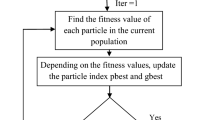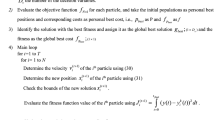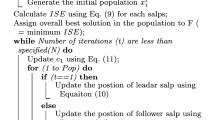Abstract
Most of the physical systems can be represented by mathematical models. The mathematical procedure of system modeling often leads to a comprehensive description of a process in the form of higher-order differential equations which are difficult to use either for analysis or for controller synthesis. It is, therefore, useful and sometimes necessary to find the possibility of some equations of the same type but of lower order that may be considered to adequately reflect almost all essential characteristics of the system under consideration. This paper proposes a new method for order reduction of higher-order linear time invariant systems based on stability equation method and particle swarm optimization algorithm. Reduced-order model will definitely be stable if the original model is stable. The superiority of the proposed method is illustrated by numerical examples of single-input, single-output systems and multiple-input and multiple-output systems. The results are compared with well-known methods available in the literature.







Similar content being viewed by others
References
D.A. Al-Nadi, O.M.K. Alsmadi, Z.S. Abo-Hammour, Reduced order modeling of linear MIMO systems using particle swarm optimization. In 7th International Conference on Autonomic and Autonomous Systems, Venice, Italy, pp. 62–66 (2011)
M. Aoki, Control of large-scale dynamic systems. IEEE Trans. Autom. Control 3, 246–253 (1968)
T.C. Chen, C.Y. Chang, K.W. Han, Reduction of transfer functions by the stability-equation method. J. Frankl. Inst. 8, 389–404 (1979)
S.R. Desai, R. Prasad, A new approach to order reduction using stability equation and big bang big crunch optimization. Syst. Sci. Control Eng. 1, 20–27 (2013)
S.R. Desai, R. Prasad, A novel order diminution of LTI systems using big bang big crunch optimization and routh approximation. Appl. Math. Model. 37(16–17), 8016–8028 (2013). doi:10.1016/j.apm.2013.02.052
E. Eitelberg, Model reduction by minimizing the weighted equation error. Int. J. Control 34(6), 1113–1123 (1981)
R.A. El-Attar, M. Vidyasagar, Order reduction by \(L_1\) and \({L_\infty }\) norm minimization. IEEE Trans. Autom. Control 23(4), 731–734 (1978)
O.K. Erol, I. Eksin, A new optimization method: big bang–big crunch. Adv. Eng. Softw. 37, 106–111 (2006). doi:10.1016/j.advengsoft.2005.04.005
K. Glover, All optimal Hankel-norm approximations of linear multivariable systems and their \({L_\infty }\)-error bounds. Int. J. Control 39, 1115–1193 (1984)
D.E. Goldberg, Genetic Algorithms in Search, Optimization, and Machine Learning (Addison-Wesley, Reading, 1989). doi:10.1007/s10589-009-9261-6
P. Gutman, C. Mannerfelt, P. Molander, Contributions to the model reduction problem. IEEE Trans. Autom. Control 27(2), 454–455 (1982)
M.F. Hutton, B. Friedland, Routh approximations for reducing order of linear, time-invariant systems. IEEE Trans. Autom. Control 20, 329–337 (1975). doi:10.1109/TAC.1975.1100953
A. Kaveh, K. Laknejadi, A hybrid multi-objective particle swarm optimization and decision making procedure for optimal design of truss structures. Iran. J. Sci. Technol. 35(C2), 137–154 (2011)
A. Kaveh, S. Talatahari, A particle swarm ant colony optimization for truss structures with discrete variables. J. Constr. Steel Res. 65, 1558–1568 (2009). doi:10.1016/j.jcsr.2009.04.021
A. Kaveh, S. Talatahari, Particle swarm optimizer, ant colony strategy and harmony search scheme hybridized for optimization of truss structures. Comput. Struct. 87, 267–283 (2009). doi:10.1016/j.compstruc.2009.01.003
J. Kennedy, R. Eberhart, Particle swarm optimization. In IEEE International Conference on Neural Networks, vol. 4, IEEE, pp. 1942–1948 (1995). doi:10.1109/ICNN.1995.488968
V. Krishnamurthy, V. Seshadri, Model reduction using the Routh stability criterion. IEEE Trans. Autom. Control 23(4), 729–731 (1978)
K.S. Lee, Z.W. Geem, A new structural optimization method based on the Harmony search algorithm. J. Comput. Struct. 82, 781–798 (2004)
A.K. Mittal, R. Prasad, S.P. Sharma, Reduction of linear dynamic systems using an error minimization technique. J. Inst. Eng. IE (I) J. EL 84, 201–206 (2004)
B.C. Moore, Principal component analysis in linear systems: controllability, observability, and model reduction. IEEE Transa. Autom. Control 26(1), 17–32 (1981)
S. Mukherjee, Satakshi, R.C. Mittal, Model order reduction using response matching technique. J. Franklin Inst. 342, 503–519 (2005)
G. Obinata, H. Inooka, Authors reply to comments on model reduction by minimizing the equation error. IEEE Trans. Autom. Control 28, 124–125 (1983)
J. Pal, Stable reduced order Pade approximants using the Routh–Hurwitz array. Electron. Lett. 15(8), 225–226 (1979)
S. Panda, J.S. Yadav, N.P. Padidar, C. Ardil, Evolutionary techniques for model order reduction of large scale linear systems. Int. J. Appl. Sci. Eng. Technol. 5, 22–28 (2009)
G. Parmar, S. Mukherjee, R. Prasad, Reduced order modeling of linear dynamic systems using particle swarm optimized eigen spectrum analysis. Int. J. Comp. Math. Sci. 1(31), 45–52 (2007)
G. Parmar, S. Mukherjee, R. Prasad, System reduction using factor division algorithm and eigen spectrum analysis. Appl. Math. Model. 31(11), 2542–2552 (2007). doi:10.1016/j.apm.2006.10.004
G. Parmar, M.K. Pandey, V. Kumar, System order reduction using GA for unit impulse input and a comparative study using ISE and IRE. In International Conference on Advances in Computing, Communications and Control, Mumbai, India, pp. 23–24 (2009)
G. Parmar, R. Prasad, S. Mukherjee, Order reduction of linear dynamic systems using stability equation method and GA. Int. J. Comput. Inf. Eng. 1(1), 26–32 (2007)
R. Parthasarathy, K.N. Jayasimha, System reduction using stability equation method and modified Cauer continued fraction. Proc. IEEE 70(10), 1234–1236 (1982)
R. Prasad, J. Pal, Stable reduction of linear systems by continued fractions. J. Inst. Eng. IE (I) J. EL 72, 113–116 (1991)
M.G. Safanov, R.Y. Chiang, Model reduction for robust control: a Schur relative error method. Int. J. Adapt. Control Signal 2, 259–272 (1988)
R. Salim, M. Bettayeb, H2 and H optimal model reduction using genetic algorithms. J. Frankl. Inst. 348, 1177–1191 (2011). doi:10.1016/j.jfranklin.2009.10.016
Y. Shamash, Stable reduced-order models using Pade-type approximations. IEEE Trans. Autom. Control 19(5), 615–616 (1974)
Y. Shamash, Linear system reduction using Pade approximation to allow retention of dominant modes. Int. J. Control 21(2), 257–272 (1975)
L. Shieh, Y. Wei, A mixed method for multivariable system reduction. IEEE Trans. Autom. Control 20, 429–432 (1975). doi:10.1109/TAC.1975.1100964
N.K. Sinha, B. Kuszta, Modeling and Identification of dynamic systems (Springer, Berlin, 1983)
C.B. Vishwakarma, R. Prasad, Clustering method for reducing order of linear system using Pade approximation (2008). doi:10.4103/0377-2063.48531
C.B. Vishwakarma, R. Prasad, System reduction using modified pole clustering and Pade approximation. In: XXXII National systems conference, NSC, pp 592–596 (2008)
C.B. Vishwakarma, R. Prasad, MIMO system reduction using modified pole clustering and genetic algorithm. Model. Simul. Eng. 2009, 1–5 (2009). doi:10.1155/2009/540895
D.A. Wilson, Optimal solution of model reduction problem. Proc. Inst. Electr. Eng. 117(06), 1161–1165 (1970)
D.A. Wilson, Model reduction for multivariable systems. Int. J. Control 20, 57–64 (1974)
Author information
Authors and Affiliations
Corresponding author
Additional information
Based on a paper presented at the IEEE International Conference on Microelectronic, Circuits and Systems (Micro-2014) held in Kolkata, India.
Rights and permissions
About this article
Cite this article
Sikander, A., Prasad, R. Soft Computing Approach for Model Order Reduction of Linear Time Invariant Systems. Circuits Syst Signal Process 34, 3471–3487 (2015). https://doi.org/10.1007/s00034-015-0018-4
Received:
Revised:
Accepted:
Published:
Issue Date:
DOI: https://doi.org/10.1007/s00034-015-0018-4




